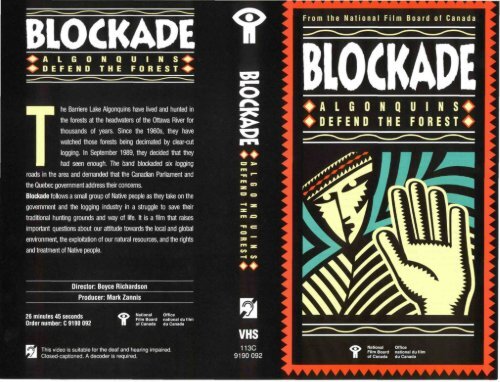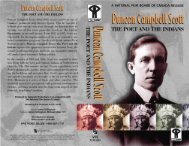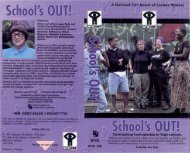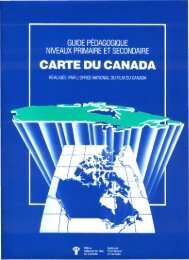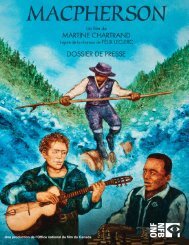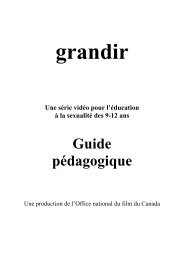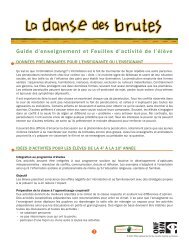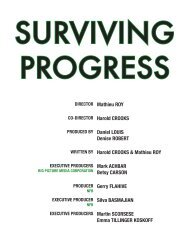algonquins defend the forest - National Film Board of Canada
algonquins defend the forest - National Film Board of Canada
algonquins defend the forest - National Film Board of Canada
You also want an ePaper? Increase the reach of your titles
YUMPU automatically turns print PDFs into web optimized ePapers that Google loves.
DEFEND<br />
N I<br />
THE<br />
FOREST<br />
he Barrière Lake Algonquins have lived and hunted in<br />
<strong>the</strong> <strong>forest</strong>s at <strong>the</strong> headwaters <strong>of</strong> <strong>the</strong> Ottawa River for<br />
thousands <strong>of</strong> years. Since <strong>the</strong> 1960s, <strong>the</strong>y have<br />
watched those <strong>forest</strong>s being decimated by clear-cut<br />
logging. In September 1989, <strong>the</strong>y decided that <strong>the</strong>y<br />
had seen enough. The band blockaded six logging<br />
roads in <strong>the</strong> area and demanded that <strong>the</strong> Canadian Parliament and<br />
<strong>the</strong> Quebec government address <strong>the</strong>ir concerns.<br />
Blockade follows a small group <strong>of</strong> Native people as <strong>the</strong>y take on <strong>the</strong><br />
government and <strong>the</strong> logging industry in a struggle to save <strong>the</strong>ir<br />
traditional hunting grounds and way <strong>of</strong> life. It is a film that raises<br />
important questions about our attitude towards <strong>the</strong> local and global<br />
environment, <strong>the</strong> exploitation <strong>of</strong> our natural resources, and <strong>the</strong> rights<br />
and treatment <strong>of</strong> Native people.<br />
Director: Boyce Richardson<br />
Producer: Mark Zannis<br />
26 minutes 45 seconds<br />
Order number: C 9190 092<br />
<strong>National</strong><br />
<strong>Film</strong> <strong>Board</strong><br />
<strong>of</strong> <strong>Canada</strong><br />
This video is suitable for <strong>the</strong> deal and hearing impaired.<br />
Closed-captioned. A decoder is required.<br />
CMIice<br />
national du film<br />
du <strong>Canada</strong><br />
VHS<br />
113C<br />
9190092
B L O C K A D E :<br />
ALGONQUINS DEFEND THE FOREST<br />
The Barrière Lake Algonquins live on<br />
<strong>the</strong> La Verendrye Wildlife Reserve in<br />
Quebec. In <strong>the</strong> 1960s, <strong>the</strong>ir way <strong>of</strong> life<br />
came under attack with <strong>the</strong> introduction<br />
<strong>of</strong> clear-cut logging, Roads were cleared<br />
through <strong>the</strong> Algonquins' traditional<br />
hunting grounds and acre after acre <strong>of</strong><br />
<strong>forest</strong> was mowed down by heavy<br />
machinery.<br />
For <strong>the</strong> next twenty years, logging<br />
continued unabated. By <strong>the</strong> late 1980's,<br />
<strong>the</strong> natural habitat <strong>of</strong> game and wildlife<br />
had been severely disrupted. Citing a<br />
United Nations study called The<br />
Bruntland Commission Report, <strong>the</strong><br />
Algonquins demanded that <strong>the</strong> federal<br />
and provincial governments listen to<br />
<strong>the</strong>ir concerns and take action to stop<br />
<strong>the</strong> devastation.<br />
Published in 1987, <strong>the</strong> report focused<br />
on <strong>the</strong> global environment and its<br />
development. The report recommended<br />
a policy <strong>of</strong> "sustainable development."<br />
an approach advocating long-term<br />
planning by government and industry<br />
for <strong>the</strong> futu re development <strong>of</strong> <strong>the</strong> world's<br />
resources. The authors <strong>of</strong> <strong>the</strong> report<br />
also advised world governments to<br />
recognize <strong>the</strong> rights and traditions <strong>of</strong><br />
<strong>the</strong>ir indigenous people. They urged<br />
that Native people be given a decisive<br />
voice in decisions pertaining to <strong>the</strong> use<br />
and development <strong>of</strong> <strong>the</strong>ir land.<br />
The Canadian government had<br />
enthusiastically endorsed <strong>the</strong><br />
recommendations <strong>of</strong> The Bruntland<br />
Commission Report. As a result, <strong>the</strong><br />
Algonquins were convinced that <strong>the</strong>ir<br />
concerns would be addressed at <strong>the</strong><br />
federal and provincial levels. Ttiey were<br />
wrong.<br />
After years <strong>of</strong> unsuccessfully lobbying<br />
<strong>the</strong> government for a hearing, <strong>the</strong><br />
community decided that it was time for<br />
more drastic action. Under <strong>the</strong><br />
leadership <strong>of</strong> <strong>the</strong>ir Chief. Jean-Maurice<br />
Matchewan. <strong>the</strong> community blockaded<br />
six new logging roads. They refused to<br />
allow workers into <strong>the</strong> area until both<br />
government and industry responded to<br />
<strong>the</strong>ir demand for a moratorium on<br />
logging.<br />
<strong>Film</strong>ed on location in <strong>the</strong> La Verendrye<br />
Wildlife Reserve during <strong>the</strong> period <strong>of</strong><br />
<strong>the</strong> blockade, this film chronicles <strong>the</strong><br />
Algonquin resistance. It explores howa<br />
tentative act <strong>of</strong> defiance grew into a<br />
well-organized, peaceful protest that<br />
challenged both industry and <strong>the</strong> state.<br />
It provides an understanding <strong>of</strong> <strong>the</strong><br />
events leading up to <strong>the</strong> summer <strong>of</strong><br />
1990. when Native groups across<br />
<strong>Canada</strong> blockaded roads and bridges<br />
and disrupted communications in an<br />
unprecedented manner.<br />
AUDIENCES<br />
Of particular interest to Native and<br />
environmental groups, this film is<br />
suitable for History, Current Affairs,<br />
Political Scienceartd Sociology classes,<br />
at <strong>the</strong> Secondary and Post-Secondary<br />
level, to stimulate discussion on issues<br />
relatedto <strong>the</strong> environment, <strong>the</strong> economy<br />
and Native rights. Community groups,<br />
pr<strong>of</strong>essional associations and government<br />
institutions can use this film as a<br />
tool for discussion and development.<br />
THEMES FOR DISCUSSION<br />
The issue <strong>of</strong> Native rights, land claims<br />
and control has drawn a great deal <strong>of</strong><br />
media attention in recent years. Survey<br />
media reports on Native issues and<br />
compare <strong>the</strong>m to <strong>the</strong> issues raised in<br />
this film. Are <strong>the</strong>re similar concerns<br />
that unite Native groups across <strong>the</strong><br />
country? How have governments responded<br />
and why?<br />
Can acts <strong>of</strong> civil disobedience, like <strong>the</strong><br />
one undertaken by <strong>the</strong> Barrière Lake<br />
Algonquins, be a productive route to<br />
social change? Research examplesand<br />
debate.<br />
In a "free market" economic system,<br />
can and should governments take more<br />
serious action to regulate industry to<br />
protect <strong>the</strong> rights <strong>of</strong> citizens and<br />
preserve <strong>the</strong> natural environment?<br />
Should <strong>the</strong> United Nations be given <strong>the</strong><br />
power to force world governments to<br />
act on problems related to human<br />
rights and <strong>the</strong> global environment?<br />
RELATED NFD FILMS<br />
• Uranium, a film about uranium mining<br />
on Native land and its impact on <strong>the</strong><br />
country and <strong>the</strong> community.<br />
(C 0190 053)<br />
• Huniers and Bombers, a film about<br />
<strong>the</strong> environmental and political<br />
implications <strong>of</strong> low level military jet<br />
training flights over Native land in<br />
Labrador. (C 0190 130)<br />
• Fort Good Hope, a film about <strong>the</strong><br />
Berger Inquiry into<strong>the</strong>MacKenzie Valley<br />
pipeline and its possible impact on<br />
Native people. (C 0177 003)<br />
RECOMMENDED READING<br />
. Our Common Future: World<br />
Commission on Environment and<br />
Development. Oxford University Press.<br />
1987.<br />
Richardson, Boyce, Time to Change.<br />
Summerhill Press, 1990.<br />
Directed ana written by<br />
BOYCE RICHARDSON<br />
Editor<br />
TORBEN SCHIOLER<br />
Cinematography<br />
BARRY PERLES<br />
Location Sound<br />
HANS DOMES<br />
MARIE-FRANCE DELAGRAVE<br />
Camera Assistants<br />
NASH READ<br />
DAWN NICHOL<br />
Research & Narration<br />
BOYCE RICHARDSON<br />
Sound Editor<br />
PAUL DEMERS<br />
Assistant Sound Editor<br />
JEAN-PIERRE VIAU<br />
Foley Artist<br />
SERGE GODIER<br />
Re-recording<br />
HANS PETER STROBL<br />
ADRIAN CROLL<br />
Post-production<br />
GRACE AVRITH<br />
Unit Administrator<br />
ROBERT SPENCE<br />
Producer<br />
MARK ZANNIS<br />
Executive Producer<br />
COLIN HEALE<br />
Produced and distributed by<br />
<strong>National</strong> <strong>Film</strong> <strong>Board</strong> ol <strong>Canada</strong><br />
Color<br />
26 minutes 45 seconds<br />
Order number: C 9190 092 (video)<br />
C 0190 092 («Ira)<br />
( 1991 <strong>National</strong> <strong>Film</strong> <strong>Board</strong> <strong>of</strong> <strong>Canada</strong><br />
P.O Box 6100. StalionA<br />
Montreal, Quebec H3C3H5<br />
Printed in <strong>Canada</strong>


